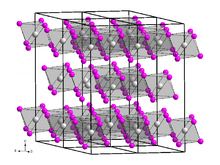Chemistry:Terbium(III) bromide
From HandWiki

| |
| Names | |
|---|---|
| Other names
terbium tribromide
| |
| Identifiers | |
3D model (JSmol)
|
|
| EC Number |
|
PubChem CID
|
|
| |
| |
| Properties | |
| TbBr3 | |
| Molar mass | 398.637 g/mol |
| Density | 4.62 g/cm3[1] |
| Melting point | 827[2] °C (1,521 °F; 1,100 K) |
| Boiling point | 1,490[3] °C (2,710 °F; 1,760 K) |
| soluble[3] | |
| Hazards | |
| GHS pictograms | 
|
| GHS Signal word | Warning |
| H315, H319, H335 | |
| P261, P264, P271, P280, P302+352, P304+340, P305+351+338, P312, P321, P332+313, P337+313, P362, P403+233, P405, P501 | |
Except where otherwise noted, data are given for materials in their standard state (at 25 °C [77 °F], 100 kPa). | |
| Infobox references | |
Terbium(III) bromide (TbBr3) is a crystalline chemical compound.[4]
Production and properties
Terbiun(III) bromide can be produced by heating terbium metal or terbium(III) oxide with ammonium bromide.[5]
- Tb2O3 + 6 NH4Br → 2 TbBr3 + 6 NH3 + 3 H2O
Solution of terbium(III) bromide can crystallize its hexahydrate. When heating it, it will dehydrate and produce some TbOBr.[6]
Terbium(III) bromide is a white solid that soluble in water.[3] It's crystal structure is same as bismuth iodide.[7]
References
- ↑ americanelements.com: Terbium Bromide
- ↑ Sigma-Aldrich Co., product no. 466344.
- ↑ 3.0 3.1 3.2 CRC Handbook of Chemistry and Physics, 87th Edition, S. 4–94
- ↑ "Terbium(III) bromide". https://pubchem.ncbi.nlm.nih.gov/compound/84452.
- ↑ Gerd Meyer, Siegfried Dötsch, Thomas Staffel (January 1987). "The ammonium-bromide route to anhydrous rare earth bromides MBr3" (in en). Journal of the Less Common Metals 127: 155–160. doi:10.1016/0022-5088(87)90372-9. https://linkinghub.elsevier.com/retrieve/pii/0022508887903729. Retrieved 2020-05-29.
- ↑ I. Mayer, S. Zolotov (September 1965). "The thermal decomposition of rare earth and yttrium bromide hydrates" (in en). Journal of Inorganic and Nuclear Chemistry 27 (9): 1905–1909. doi:10.1016/0022-1902(65)80042-2. https://linkinghub.elsevier.com/retrieve/pii/0022190265800422. Retrieved 2020-05-29.
- ↑ Jean D'Ans, Ellen Lax (1997). Taschenbuch für Chemiker und Physiker. Springer DE. p. 1386. ISBN 354060035-3.
 |

